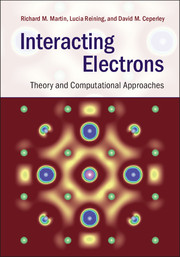Book contents
- Frontmatter
- Dedication
- Contents
- Preface
- Acknowledgments
- Notation
- Part I Interacting electrons: beyond the independent-particle picture
- Part II Foundations of theory for many-body systems
- 4 Mean fields and auxiliary systems
- 5 Correlation functions
- 6 Many-body wavefunctions
- 7 Particles and quasi-particles
- 8 Functionals in many-particle physics
- Part III Many-body Green's function methods
- Part IV Stochastic methods
- Part V Appendices
- References
- Index
7 - Particles and quasi-particles
from Part II - Foundations of theory for many-body systems
Published online by Cambridge University Press: 05 June 2016
- Frontmatter
- Dedication
- Contents
- Preface
- Acknowledgments
- Notation
- Part I Interacting electrons: beyond the independent-particle picture
- Part II Foundations of theory for many-body systems
- 4 Mean fields and auxiliary systems
- 5 Correlation functions
- 6 Many-body wavefunctions
- 7 Particles and quasi-particles
- 8 Functionals in many-particle physics
- Part III Many-body Green's function methods
- Part IV Stochastic methods
- Part V Appendices
- References
- Index
Summary
Art is the elimination of the unnecessary.
Pablo PicassoSummary
Condensed matter is constituted by a huge number of electrons and nuclei interacting with Coulomb potentials. The topic of this chapter is a way to deal with the full, coupled problem by separating it into a part that is tractable and the rest that is approximated. This naturally leads to the appearance of dynamical fields, and to the concept of “quasi-particles” that have the same quantum numbers as non-interacting electrons. The quasi-particles obey equations where the potential and bare interactions in the hamiltonian are replaced by dynamical self-energies and screened interactions that can describe many of the effects of correlation. In this chapter we discuss the intuitive concepts behind this approach in general terms to motivate the more rigorous formulations and approximations used in the Green's function methods of the following chapter and in Part III.
The first equations of this book, Eqs. (1.1) and (1.2), express the fundamental theory of matter in terms of electrons and nuclei that interact with Coulomb potentials. For systems with only a few electrons, a solution of the problem can be obtained by exact diagonalization, using configuration interaction methods. For many-electron systems one has to resort to other methods. For example, QMC stochastic simulations (Chs. 22–25) are among the most accurate methods known to calculate certain expectation values, such as equilibrium thermodynamic properties, total energies, the density, and various static correlation functions like those in Ch. 5. Other properties such as excitation spectra are more difficult to access with QMC. Straightforward perturbation theory is, in general, not appropriate since interactions among the electrons are of the same order of magnitude as the independent-particle terms. Hence, we must develop other approaches.
One strategy that gives access to equilibrium thermodynamic as well as dynamical excitation properties is to separate the interacting many-body problem into a part that is tractable by some means and the rest of the problem that is dealt with more approximately. The present chapter is devoted to this idea. It is a prelude to many-body Green's function methods; the aim is to provide a unified framework for the developments in Chs. 8–21, along with a qualitative description of the most relevant quantities.
- Type
- Chapter
- Information
- Interacting ElectronsTheory and Computational Approaches, pp. 144 - 168Publisher: Cambridge University PressPrint publication year: 2016



